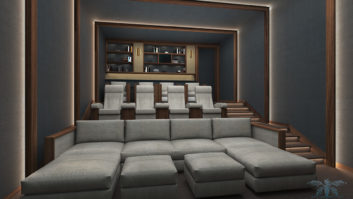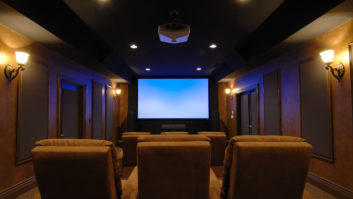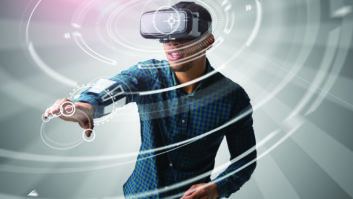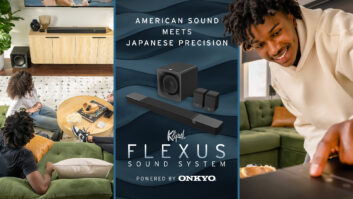
How do we communicate the value of immersive audio to our clientele? Do we tout the speaker count? The channel count? By boldly claiming that bigger is better, but blind to the horrifying image this loudspeaker invasion might present, all the while missing the real reason to consider immersive audio in a private cinema?
Like so many truly remarkable things, immersive audio requires a closer look if it is to be appreciated. We in the industry know how good it can be, so we enthusiastically assume our clientele will want it. We tell them about a dome of sound, of objects moving about them, of ambience. Do we ever say why? If we are going to be successful in sharing our passion for the advantages of private cinema, such as immersive audio, we need to impart something of substance, a deeper appreciation of our craft for our clientele to grasp.
Related: Survival of the Finest
Do we consider the impact immersive audio has had on the film industry itself? What do the creators of the art consider when it comes to immersive audio? After all, film is the art form our work is intended to display. If we can show our clientele how a private cinema with an immersive audio system will enhance their enjoyment, that will be a strong argument. If we can share with them how the creators of the films use immersive audio to tell their stories, the argument becomes even stronger.
With that in mind, the following are some insights from an Oscar-nominated supervising sound editor, a respected industry audio consultant, and a major studio executive engineer to help pull back the veil and share with us, and in turn the clientele we serve, the artist’s insight to the advantages of immersive audio and why it is important to get it right.
How important is sound for movies and film?
Our industry audio consultant quotes George Lucas, “sound and music are 50 percent of the movie experience” and goes further to state that now, 40 years later, we have immersive audio and our palate of creative tools has increased dramatically. Our supervising sound editor relates, “My job is similar to that of the cinematographer where they are responsible for the ‘look’ of the film; I am responsible for the ‘sound’ of the film. I work with a team of technicians, engineers, and artists, creating, editing, and mixing a soundscape that supports the telling of the film’s story.” Our studio executive agrees that it is a collaborative, artistic process, vital to the success of the film, attested to by the director’s and producer’s steadfast presence in the “expensive seats” of the mixing stage.
Describe the work and effort that goes into film sound.
“It is a lot,” explains our supervising sound editor, “in a way it is like a musical composition. We are creating a score that tells the story through sound.” He goes on to explain, “We are crafting the sound elements, using different sounds, different frequency ranges even, that will affect the audience and move them emotionally so the story is more powerfully conveyed, where the audience becomes completely involved.” Our executive sees it as creating an environment or world of sound where very little is merely recorded. “It is an exhaustive process where dialog, which is of primary importance, must be married to the performance and the supporting sounds at all costs. Whether it is a well-captured organic performance or painstaking ADR (automatic dialog replacement) that appears to be organic. People don’t realize the extent that is taken to create the perfect supportive sound to really drive the story home. For example, in Apollo 13, a recorded sound effect was modulated (pitch bend) in order to create dissonance with the score and create greater tension.” Now that’s attention to detail!
How aware are audiences of the sound in film?
From our supervising sound editor’s perspective, the audience is clearly aware of the big production sound effects but aren’t likely to realize how important it is in subtle films like a drama. “But since we are creating sounds that are supposed to be real, subtle sounds, it is harder in a way.” People know what natural sounds are, whereas they do not know what a sci-fi battle really sounds like. “With natural sounds there is nowhere to hide, and if they are not done correctly, it is recognizable. On the other hand, when a scene is supported by well-executed natural sounds, it is amazing what the impact can be.” Our studio executive agrees, but points out the importance of those unknowable but iconic effects. “Ben Burtt created the ethos of the genre with the voice of R2-D2, the lightsaber, and Darth Vader’s heavy breathing. Ironically the TIE fighter would have made no sound in space, but the story would be missing something special without that sound!”
How important are the immersive sound formats to film sound?
Our industry audio consultant points out, “In Gravity, Ed Harris, who played a key role in the opening scene and was represented entirely by his voice as audio effects, evokes a sense of space and movement. Prior to immersive audio, this would not have been nearly as effective and impacting!” For our supervising sound editor, “There is always a discussion we have with the production company as to what they want to deliver. If we are going to do a more immersive mix, the de-facto standard is Dolby Atmos. Then we down-convert from there. One of the great advantages of having more distinct points of articulations for sound, i.e., Dolby Atmos or Dolby 7.1, is that we are able to add more details and sparks of life to the track without cluttering up the dialog in the center channel. For example, in the real world we can be in a loud restaurant and yet still focus on the person talking to us across the table due to our binaural hearing and our brain being able to localize on the point source of interest. Therefore, with more speakers and more point sources for us to play with, we are able to create an intricate and interesting soundscape, yet still allow the viewer to focus on the center channel dialog track.” Our studio executive points out, “Movie scores are being enhanced through immersive formats as well. Scores are being recorded in multi-channel, placing mics to pick up ambience and create space, becoming immersive sound elements themselves.”
Related: The State of Surround Sound
How are immersive soundtracks being realized in theaters?
Our supervising sound editor sees some of the better commercial theaters doing a good job of providing auditoriums where the audience can see and hear the films accurately to the artist’s intent. And all our industry experts agree that the DCP (Digital Cinema Package, the high-resolution format used in digital cinema), with its level of video resolution and un-compressed audio, has the potential of delivering shockingly high quality. When asked about the impact of private cinemas, their feedback was illuminating. Our industry audio consultant points out that, although the consumer resolution and even the channel counts are less than what is found on a commercial DCP, “the quality of the systems and the level of design and engineering in these private cinemas, make the overall experience equal to the very highest quality commercial theaters. There is no need for the confusion, with all of today’s tools and the industry’s capabilities, it is well worth the effort to do it well!” Our studio executive follows with a call to educate the public: “People experiencing well-executed private cinemas may well help to drive the industry to keep its sights high on all levels.”
We should thank our friends from the film industry for sharing their insights into their art. We are privileged to create venues within which our clients will enjoy those works. They had much more to share than we have room for in this column, but what is clear is their passion for their art and the desire for the audience to keep listening and to not miss anything. I see that desire as a challenge to our industry, and it occurred to me — what if we were talking about another art form? What would we be willing to miss if we were willing to compromise? The light of Monet, the detail of Michelangelo, or the perfection of Leonardo?






